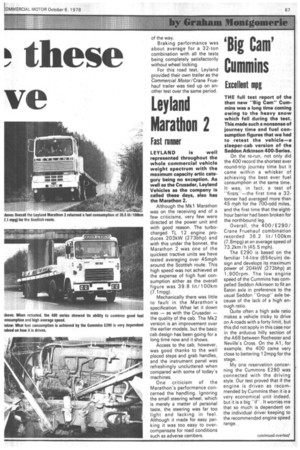'Big Cam' Cummins
Page 71

If you've noticed an error in this article please click here to report it so we can fix it.
Excellent mpg
THE full test report of the then new "Big Cam" Cum mins was a long time coming owing to the heavy snow which fell during the test.
This made such a nonsense of journey time and fuel consumption figures that we had to retest the vehicle—a sleeper-cab version of the Seddon Atkinson 400-Series.
On the re-run, not only did the 400 record the shortest ever round-trip journey time but it came within a whisker of achieving the best ever fuel consumption at the same time. It was, in fact, a test of 'firsts'' —the first time a 32tonner had averaged more than 45 mph for the 700-odd miles, and the first time that the eighthour barrier had been broken for the northbound leg.
Overall, the 400/E290/ Crane Fruehauf combination recorded 36.2 lit/ 100km (7.8mpg) at an average speed of 73.2km/h (45.5 mph).
The E290 is based on the familiar 14-litre (854cuin) design and develops its maximum power of 204kW (273bhp) at 1,900rpm. The low engine speed of the Cummins has compelled Seddon Atkinson to fit an Eaton axle in preference to the usual Seddon "Group" axle because of the lack of a high enough ratio.
Quite often a high axle ratio makes a vehicle tricky to drive on A-roads with a forty limit, but this did not apply in this case nor in the arduous hilly section of the A68 between Rochester and Neville's Cross. On the Al, for example, the 400 came very close to bettering 12mpg for the stage.
My one reservation concerning the Cummins E290 was connected with the driving style. Our test proved that if the engine is driven as recommended by Cummins then it is a very economical unit indeed, but it is a big "if". It worries me that so much is dependent on the individual driver keeping to the recommended engine speed range.


























































































































































